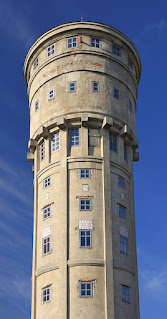The Westgate Water Tower
The Westgate Water Tower, also known as the Lincoln Water Tower, is a historic water tower located on Westgate in Lincoln, England. It was built in 1911 by the Lincoln Corporation Waterworks to provide a high-level water supply to the city.
 |
| The Westgate Water Tower / Photograph by Mike Peel |
The tower is 120 feet (37 m) tall and has a capacity of 300,000 imperial gallons (1,360,000 L) of water. The tower is built in the Edwardian Baroque style and is decorated with the fleur-de-lis, the symbol of Lincoln Cathedral's patron saint, Mary Mother of Jesus. The tower was commissioned in response to an outbreak of typhoid fever in the city in 1904-1905, which killed 113 people. The outbreak was caused by contaminated water from the River Witham, which was the city's main water source at the time.
The Westgate Water Tower was a major engineering feat for its time. The tower was built on a hilltop site, which required the construction of a deep well to reach the water table. The water was then pumped to the top of the tower using a steam engine. The tower was in use until the 1960s, when it was replaced by a more modern water treatment plant. The tower has since been converted into a museum and is open to the public for tours.
The Westgate Water Tower is a Grade II listed building and is a significant landmark in Lincoln. The tower is a reminder of the city's important role in the development of water engineering.



Comments
Post a Comment